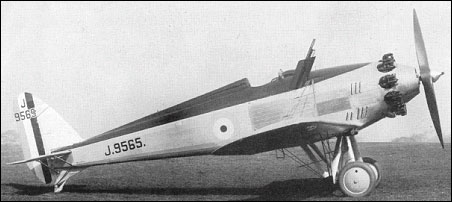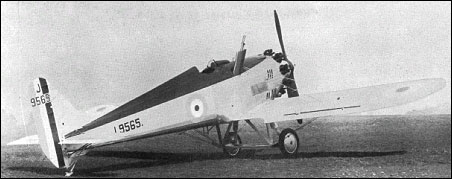|
| Usually known as the COW-Gun Fighter, this prototype monoplane was one of two ordered by the Air Ministry (with the unorthodox Vickers Type 161) in fulfilment of Specification F.29/27. This called for an aircraft armed with the 37mm Coventry Ordnance Works (COW) cannon that had been evolved during World War I and was thought to have potential as an anti-bomber weapon. The COW gun was to be mounted at an upward angle of at least 45° from the horizontal, with the idea that the fighter would approach enemy bombers from below and astern. The Westland prototype was, in effect, an enlargement of the F.20/27 prototype, and had the COW gun mounted to fire upwards at 55°, with the breech casing in the starboard side of the open cockpit. Aiming was by means of a periscopic sight, and a special "ammunition dispenser" carried 39 rounds. The fighter was of similar all-metal construction to the F.20/27 and, like the latter, was first flown with a small fin and rudder which later had to be considerably enlarged to obtain satisfactory spinning characteristics. Powered by a 485hp Bristol Mercury IIIA nine-cylinder air-cooled radial, the F.29/27 first flew in December 1930, but the RAF quickly lost interest in the COW gun. With a Mercury IVA, the COW-Gun Fighter remained at the A & AEE until July 1934.
| WEIGHTS |
| Take-off weight | 1762 kg | 3885 lb |
| Empty weight | 1186 kg | 2615 lb |
| DIMENSIONS |
| Wingspan | 12.45 m | 41 ft 10 in |
| Length | 9.09 m | 30 ft 10 in |
| Height | 3.22 m | 11 ft 7 in |
| Wing area | 20.62 m2 | 221.95 sq ft |
| PERFORMANCE |
| Max. speed | 296 km/h | 184 mph |
| Ceiling | 8900 m | 29200 ft |
 | A three-view drawing (812 x 1071) |
| Hugh Soar, e-mail, 31.01.2014 17:48 What was the colour scheme please. I am creating a 1 /72 scale model from scratch. Thanks in advance. reply | | dafag, 20.06.2011 14:19 Maybe the RAF decided that it was unnecessary since German bombers were lacking in tail armament, while RAF bombers were not. reply | | Stuart Willard, e-mail, 19.07.2010 13:35 Apparently it was mostly down to the thinking in the Air Ministry that the increasing speed of fighter aircraft was so reducing the window of successful use was rapidly declining to the position where it held little or no advantage over conventional set ups. The German success later puts that argument into doubt I think. The thinking only came back in the form of turrets (Defiant later Beaufighter) but size weight etc largely meant that use was limited and later dropped altogether. reply | | Johnny ,45, e-mail, 24.04.2010 01:21 Actually, the upwards firing gun idea has been around since early WWI...I couldn't say what the exact first attempt was, but it was one of Albert Balls favorite tactics, since it allowed the attacking plane to get into the "blind spot" under the enemies tail, where he couldn't be seen or fired at, and then down the enemy "at will". It became feasible after they introduced the "Foster mount", a set of rails that allowed a pilot to tilt a wing-mounted Lewis machine gun back to reload or re-cock it, without having to reach up over the wing. Although not it's intended purpose, pilots found that they could use it to fire the gun upwards into an enemies belly. It was an effective tactic, and I think the British even designed a few "night fighters" to fire MG's or even small cannon upwards, to attack bombers or Zeppelins. I don't know why the RAF abandoned the concept before WWII, although the Boulton-Paul Defiant was a bomber-killer and it's turret guns could fire as "schrage musik" guns. I think you're probably right that the Japs were the Germans inspiration...in many ways, the Japanese were very good at seeing effective ideas and using them, although many of their gambles proved wrong in the end. Maybe the RAF decided that it was unnecessary since German bombers were lacking in tail armament, while RAF bombers were not. reply | |
| | Jim Lloyd, e-mail, 04.08.2009 07:21 Possibly, but a more likely source was that the Japanese used it prior to the German use during the war. reply | | leo rudnicki, e-mail, 23.04.2009 02:14 This must be where the German Schrage Musik idea came from reply |
|
Do you have any comments?
|
| 
COMPANY
PROFILE
All the World's Rotorcraft
|








